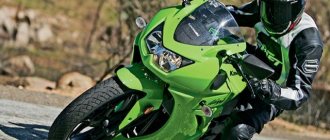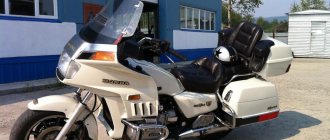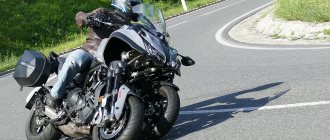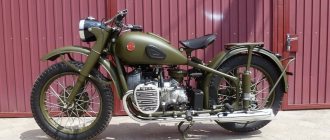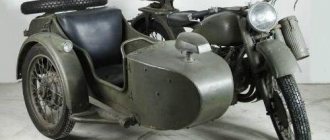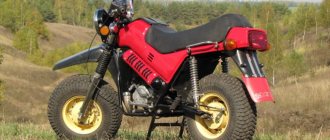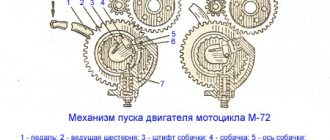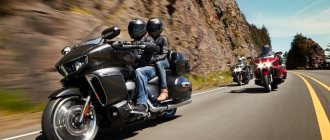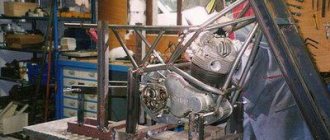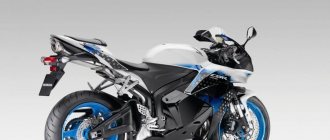Motorcycles and wide rear wheel
A wide rear wheel on a motorcycle is the dream of many chopper owners. As a rule, such a rear roller about thirty centimeters wide is a feature characteristic of custom cars, in which everything, or almost everything, has undergone deep alterations.
The wide rear wheel is usually installed on two types of motorcycles, cruisers and monstrous customs, often made from sportbikes and intended for drag racing. But since the second type mentioned is vanishingly rare in our reality, let’s talk about the first. Most chopper riders dream of a wide rear wheel for their motorcycle, sometimes even ironically calling it “VShK” - Great Wide Wheel. This is the same part of the style as, for example, a long fork. And, like such a fork, the wide rear wheel also makes its own adjustments to the handling of the motorcycle.
The main thing you should know is that the wider the rear wheel of a motorcycle, the more stable it is in a straight line, but the worse it is at maneuvering. You don’t have to look far for an example - the Yamaha XV 1700 Warrior and Suzuki M109R Boulevard choppers are already equipped with wide rear rollers from the factory. As a result, they hold the road superbly, but they have a very decent turning radius, and turns are given to them with a certain amount of effort. You can install a wide rear wheel on any motorcycle, but the complexity and cost of such tuning depend on the specific bike. So, in the case of a cardan drive, this will be the most difficult - you will have to digest the frame and figure out how to avoid the wheel moving to the side. With a belt and chain it is easier, but not much - you will still have to redo the frame or change the pendulum, but it will be easier to put the wheel straight. In addition, when modifying the frame, it is much easier to change the length of the chain or order a new belt than to lengthen the driveshaft.
The feasibility of such tuning is a big question due to its rather high cost. Yes, a wide rear wheel is a pride for the chopper and its owner, but a motorcycle that is used every day does not really need such expensive tuning. Although many bikers do not care about practicality. Wide rear wheels, long forks, short fenders... Is this convenient? Of course no. But is it stylish? Of course yes. To each his own.
ragingbiker.ru
Motocross in the Soviet Union
In the USSR, motocross was one of the most popular sports. Of course, it could not compare with football and hockey, but it remained widespread and successful. The first official championships in the country began to take place back in the 50s. The first international competition took place in 1954. In 1956, the USSR motorcycle club became part of the international federation.
The Union produced good motocross motorcycles, the prices of which suited everyone, but the basis of the sport was Java and CZ. It was this technique that Soviet athletes performed at the international level.
For the first time, Soviet racer Gennady Moiseev won the world championship in 1974. Before this, it was not possible to rise above the 3rd step.
Typically, Soviet riders took part in races only on domestic equipment or motorcycles produced in socialist countries. But incidents also happened, like with Moiseev. The athlete did not have the opportunity to compete on a Czech motorcycle. They just didn’t have time to bring him. As a result, in order not to withdraw from the competition, he agreed to the KTM team’s offer to compete on Austrian equipment. This brought him victory in 1974, 1977 and 1978.
It will also be interesting: Ural motorcycles and the fate of the Irbit plant
Motorcycle names in motorcycle jargon
Names of motorcycles in motorcycle jargonlara868May 23rd, 2011 One day I was walking down the street. I heard music blaring at the top of my lungs, well, I think the Caucasians opened the windows in the car and turned up the music at full blast... I turn around: at the traffic light there is a motorcycle with music, it started off from the traffic light, everyone is looking after it, everyone well unusual, a motorcycle and with music)) Klyokha is a Kawasaki motorcycle of the KLE series (enduro type).
Shame is a Honda chopper/cruiser of the Steed series. Produced until 1998. Viagra is a Yamaha cruiser motorcycle of the Virago series. Produced until 2000. For some reason it is considered the ideal women's motorcycle. Zakhar is a Kawasaki ZXR series motorcycle. Zizer is a motorcycle of the Kawasaki brand of the ZZR series (sport-tourist type). Sibiha is a classic motorcycle of the Honda brand of the CB series (most often the CB400 variety is called a sibiha). Cactus is a motorcycle of the Kawasaki brand of the Xanthus series. Stick is a heavy cruiser motorcycle from the Honda VTX series. Vatrushka is a sports tourer of the Honda brand VTR1000 Firestorm series Bandos is a road/street motorcycle of the Suzuki brand of the GSF Bandit series Razor is a sports motorcycle of the Honda brand of the CBR series Africa is a motorcycle of the Honda brand Africa Twin series. A trike is a three-wheeled motorcycle, and two wheels can be either in the front (for example, a Can-Am Spyder) or in the back (very often homemade or small factory batches). Vyfer is a powerful touring motorcycle of the Honda brand of the VFR series (type - sport tourist). Yobyr is a motorcycle of the Yamaha YBR series (type - road). Lightweight and cheap motorcycle for beginners Hayabusa is a powerful motorcycle of the Suzuki brand of the GSX 1300R Hayabusa series (type - sport tourism). Jixer is a Suzuki motorcycle of the GSX-R series (type - sport) Tygydym is a Yamaha motorcycle of the TDM series (type - touring enduro). TERMS hardtail - (from the English hard-tail) a really rigid rear suspension, that is, the wheel is directly attached to the frame. Softtail - (from the English soft-tail) a type of suspension that looks like a hardtail, but has a powerful shock absorber hidden inside the frame. A chandelier is a system of additional, usually chrome-plated headlights on choppers and road cars. The fence is the windshield of a motorcycle. The foot is the brake pedal. Grill - radiator grille Watermelon rind - Jet type motorcycle helmet, without chin protection. It got its name because it protects in case of an accident, much like a watermelon rind placed on the head. Sharks - (English Shark) helmets of the Shark brand Ebloduy - headwind. can - muffler. Roller - the rear wheel is very wide (similar to an asphalt roller). Typically used on tuned motorcycles. balloon - usually this is a rear tire, although in principle any tire (not even a motorcycle one) can be called a balloon. display meter - any dial instrument on the dashboard. Wheelie - (English wheelie) - riding on the rear wheel. Stoppie - (English stoppie) - a spectacular trick consisting of calculated braking with the front brake. In this case, the front fork of the motorcycle is compressed until it stops, and the rear wheel of the motorcycle is lifted off the ground. Lowside - (English "lowside") - a situation when a motorcycle falls on its side and the motorcyclist sits on it immediately until the moment of landing on the asphalt. The most common cause is loss of traction on the front wheel. In this case, the motorcyclist slides behind the motorcycle (or with it), in contrast to highside, when the motorcyclist, on the contrary, “overtakes” the motorcycle. Highside - (English “highside”) - happens for a combination of three reasons: loss of traction of the rear wheel with road surface, its significant deviation from the trajectory, a sharp restoration of traction. When skidding the rear wheel, the pilot instinctively releases the gas, causing the rear wheel to sharply restore traction and catapult the rider forward of the motorcycle (hence the name of the term). https://www.jargon.ru/ lara868.livejournal.com
Sports (racing)
Have you ever heard or seen something rushing along the highway, making a loud buzzing sound? These are sports motorcycles, in which the emphasis is on speed and controllability. To achieve the best dynamics, engineers equip them with powerful motors and try to use more light alloys. To improve aerodynamics, sports motorcycles are covered with a body kit made of plastic or thin-sheet light metal.
The seat on a sportbike is tilted forward; for better streamlining, the driver rests his chest on the tank during the race. The wheels are usually light alloy, with relatively wide tires (for better grip), and a smooth semi-slick or slick tread. Models designed for use in the city have lighting equipment and a signal; purely sports (only for the track) bikes lack these elements, which is done to make it easier.
Sports motorcycle engines are highly accelerated, usually in-line or V-shaped, with 1-4 cylinders. They produce 2 or more times higher power per unit volume than classics or tourers. Engines are usually high-speed (up to 10 thousand rpm or more), which is what causes the characteristic buzzing sound during operation.
Suzuki Hayabusa © Overdrive
Since races are held in different classes, engine volume can vary from 100-200 cm³ to a liter or more. To ensure controllability and safety, sports motorcycles are equipped with powerful brakes. Typical representatives of the sportbike class are the famous Suzuki Hayabusa, the no less famous Yamaha R1, and the Honda CBR1000RR Fireblade.
Yamaha R1 © Yamaha Motorsports
Alas, such bikes are not well suited for long-term driving, and on roads of average or low quality they do not behave in the best way, and the engine life is not very long due to overdrive. Another disadvantage is the high price (up to tens of thousands of dollars), especially for the fastest models.
Motoviewer.ru - blog about motorcycles
We continue the topic of types of motorcycles. The first part was devoted to road motorcycles, and I admit, I find it difficult to name the second conditional category. I, of course, described it as “Choppers”, but this is a little misleading. Choppers are more of a special case. A distinctive feature of this type of bike is its large weight, long wheelbase and low-speed, large-capacity engine.
Well, let's start in order, shall we?
Beaver/beaver
It can safely be called the great-grandfather of cruisers and choppers. Beaver (from the English “bob” - short hair) is a very specific motorcycle. This is not a mass-produced motorcycle and the recipe for its preparation is extremely simple: we take a factory cruiser (more on them a little later) motorcycle, cut off everything unnecessary (rear fender, front fender, fairings, muffler, change the saddle to a lighter and more uncomfortable one, and sometimes even remove the front brake ), we tune and boost the engine in every possible way - everything in order to get the most out of it. Due to the fact that there were simply no other motorcycles at that time, beavers were used for racing.
Harley Davidson Yamaha Triumph
Chopper
The most interesting thing is that the motorcycles that we used to call “choppers” are never choppers at all. So what exactly is it? From the English “chop” - chop, chopped off. Initially, choppers were heavy motorcycles modified for racing. In essence, they are similar to beavers, but the chopper has a seriously modified front fork and frame. Choppers have a high handlebar, often quite shocking, a backrest, and forward footpegs. No plastic fairings. They are distinguished by low-sided engines, but at the same time they are not deprived of “tops”, which are a consequence of boosting the engine. A typical attribute of many neo-choppers is a rear “roller” (a wide wheel of small diameter), a frame without rear suspension, an unusually shaped gas tank and, of course, an abundance of chrome parts. The first enthusiasts made choppers based on Harley-Davidson and Indian motorcycles. Mass-produced motorcycles cannot be called choppers, but some manufacturers produce chopper-style motorcycles.
"Captain America" Harley Davidson Indian
Cruiser/Cruiser
Let's start with the fact that this is already a production motorcycle. The name speaks for itself - Cruise/Cruising, which means “cruise”, “follow the course”. Low seat, upright seating position with footrests placed far forward, lots of chrome, significant weight. Cruisers are not designed for very fast riding or riding over rough terrain, but sitting on such a motorcycle, you really feel like a steam locomotive on rails - just king of the road. But at the same time, the engine has enormous power and high torque at low speeds. Most often found with a V-shaped two-cylinder engine of significant volume. Right off the bat, they can easily be confused with a chopper. The main differences between a cruiser and a chopper are a larger tank, larger fenders, additional headlights, a lower and more comfortable steering wheel and a lot of other additional accessories that you will not find on a chopper.
Kawasaki Vulcan Suzuki Intruder Honda Shadow
Dragster
This is another type of chopper-type motorcycle, but of a more modern nature. Motorcycles originally designed for drag racing. They are distinguished by their large mass and enormous engine torque.
Harley-Davidson V-Rod Yamaha V-Max
Custom
The concept of custom itself is much broader, but in a particular case it is used to determine the class of a motorcycle. In the modern motorcycle lexicon, the term "custom" is used for any modified motorcycle, but this is somewhat misleading. Custom - “made to order”, i.e. a motorcycle that was originally built from scratch, and not rebuilt, as is commonly believed. Motorcycles are most often modified to look like a beaver or a chopper - this is the main difference between just a “chopper” and a “custom chopper style”. Custom bikes, in fact, can be not only in the chopper style, but also in any other style. Another distinctive feature of a custom car is that appearance plays a leading role here, moreover, often to the detriment of driving performance.
Silver Stork Black Widow DUster
That's probably all about heavy motorcycles. On the one hand, they all have a lot in common, and, I would even say, they are getting used to grinding in, but, nevertheless, there are significant differences (although not as obvious as with road ones).
Ready to listen to any criticism.
www.motoviewer.ru
Popularity of motocross
Any motorcycle racing, even the most unusual, finds a response in the world. And motocross is a competition with a rich and very interesting history, it has a huge, multimillion-dollar fan club around the world. Championships attract millions in the stands and in front of silver screens.
Many companies sponsor such competitions. And they are not always associated with motorcycles.
Large manufacturing companies have their own factory teams for motocross and rally racing, like Dakar. Selling motocross motorcycles has always been a profitable business. Every year the series is updated and new ones appear. Companies compete not only on the track, but also in technology. This competition has a great impact on technological progress in the industry.
Cross motorcycles video. Technology from the 70s to the 90s. Living history:
Cross (enduro)
Enduro motorcycles are designed for off-road riding; their name comes from the English. "endurance" - "endurance". The most famous representatives of this class are motocross motorcycles designed for cross-country racing. An example of a motocross bike is the Kawasaki KXF.
Kawasaki KXF250 © Pinterest
Distinctive features of enduro are a “thin” design without heavy parts, the presence of shields that protect the motorcyclist from flying dirt and splashes, and a body kit made of impact-resistant plastic. The suspension of a cross-country motorcycle is quite rigid, has a rigid ride and high reliability, because while riding you have to overcome potholes and jump from hills, and it must withstand these impacts.
Since the bike must be light, manufacturers do not equip it with such frills as an electric starter, a soft saddle, or a luggage rack. The enduro seat is usually narrow and quite rigid, since during the ride a significant part of the load falls on the legs (standing on the pegs), the rider often has to rise above the saddle.
Models intended only for motocross and not designed for everyday driving on public roads often lack signal and lighting equipment, since they are not needed in competitions. Enduro wheels are usually spoked, as the spokes distribute shock loads better than cast wheels, and such wheels are not prone to cracking. Models suitable for city driving usually have a combined tread (for dirt and asphalt), while purely cross-country models are equipped with aggressive mud tires with a large pattern.
Most enduros are equipped with single-cylinder engines (both 2-stroke and 4-stroke), running at high speeds to achieve maximum torque. Engine displacement rarely exceeds 500 cm³, although there are exceptions. Thus, models for long trips (like the Honda VFR1200X Crosstourer) can have a displacement of more than a liter.
Honda VFR1200X Crosstourer © Mototrader.ch

